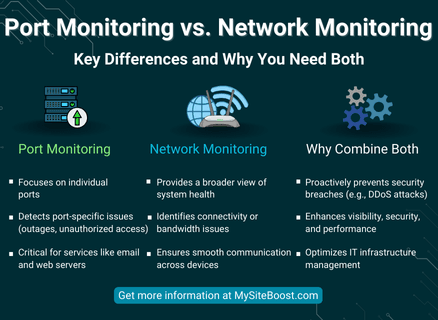In the digital age, ensuring the security, reliability, and performance of an organization’s IT infrastructure is essential. For IT administrators, network engineers, and business decision-makers, understanding the distinct roles of port and network monitoring—and how they complement each other—is crucial for maintaining robust cybersecurity and operational efficiency. This article delves into the key differences between port and network monitoring and explains why integrating both strategies is essential for comprehensive IT management.
Port Monitoring vs. Network Monitoring: Key Differences and Why You Need Both
Iliya Timohin
2024-12-20

Port Monitoring vs. Network Monitoring: Key Differences and Why You Need Both
Understanding Port Monitoring
Port monitoring focuses on individual ports within your network infrastructure. Each port serves as a communication endpoint for specific types of data, and port monitoring ensures that these endpoints are open, responsive, and functioning as expected.
Key Functions of Port Monitoring
- Detection of Port Outages and Unauthorized Access: Port monitoring is vital for identifying issues such as port outages or unauthorized access attempts. By continuously tracking the status of each port, IT teams can quickly detect anomalies that could indicate potential security threats or operational failures. Unauthorized access attempts can be immediately flagged, allowing for swift remediation to prevent data breaches.
- Granular Insights for Targeted Troubleshooting: Unlike broader monitoring tools, port monitoring provides detailed, granular data that helps pinpoint exact issues at the port level, making it invaluable for targeted troubleshooting and rapid problem resolution. This specificity aids in isolating the root cause of issues, enabling IT teams to address them effectively without unnecessary downtime.
- Ensuring Accessibility of Critical Services: Port monitoring plays a crucial role in ensuring that critical services such as email and web servers remain accessible through their designated ports. This is essential for maintaining business continuity and preventing service disruptions that could impact productivity and customer satisfaction.
Understanding Network Monitoring
Network monitoring provides a comprehensive view of the entire network’s health and performance, encompassing all the interconnected devices and systems. It is designed to identify larger-scale issues that affect the overall network infrastructure.
Key Functions of Network Monitoring
- High-Level Overview of Network Health: Network monitoring tools offer a high-level overview of network activity, helping IT teams understand the broader context of system performance and health. This includes tracking metrics such as latency, throughput, and error rates, which are crucial for assessing network efficiency.
- Identification of Bandwidth Bottlenecks and Connectivity Failures: Network monitoring is essential for spotting larger-scale problems, such as bandwidth bottlenecks and connectivity failures, that could impact the efficiency and reliability of the entire network. Identifying these issues early allows IT teams to optimize network resources and prevent potential disruptions.
- Ensuring Smooth Communication Across Devices and Applications: By monitoring network performance, businesses can ensure smooth communication across devices and applications, which is critical for operational efficiency. This includes ensuring that data flows seamlessly between servers, workstations, mobile devices, and cloud services.
Why You Need Both Port and Network Monitoring
While port and network monitoring each serve distinct purposes, combining them provides a comprehensive security and performance strategy that enhances overall system visibility and resilience.
Benefits of Combining Port and Network Monitoring
- Proactive Prevention of Security Breaches: By using both monitoring strategies, businesses can proactively prevent security breaches, such as DDoS attacks targeting open ports, while maintaining optimal network performance. Port monitoring can quickly identify and mitigate threats specific to entry points, while network monitoring provides an overarching security posture against broader threats.
- Enhanced System Visibility and Security: Integrating port and network monitoring offers enhanced visibility into both specific and broader system activities, improving security measures and operational efficiency. This dual approach ensures that both micro-level details and macro-level trends are monitored, providing a holistic understanding of network health.
- Comprehensive Troubleshooting: The combination allows for both targeted troubleshooting at the port level and broader network diagnostics, ensuring quick and effective problem resolution. This reduces downtime and enhances the reliability of IT services, ultimately supporting business operations.
How to Effectively Combine Port and Network Monitoring
- Integrated Monitoring Solutions: Choose monitoring tools that offer both port and network monitoring features. This integrated approach allows for seamless data collection and analysis, providing a unified platform for comprehensive oversight. Solutions that consolidate monitoring data into a single dashboard can streamline operations and improve response times.
- Automated Alerts and Reporting: Set up automated alerts and detailed reporting to keep IT teams informed of any anomalies or potential issues, enabling timely intervention and resolution. Automated alerts can be configured to trigger on specific thresholds or events, ensuring that critical issues are addressed promptly.
- Regular System Audits and Updates: Conduct regular audits of your monitoring strategies and update them as necessary to adapt to new threats and ensure continuous protection. This includes revisiting security protocols, updating software, and ensuring that monitoring tools are configured to detect the latest types of threats.
- Training and Best Practices: Ensure that IT staff are trained on the latest best practices for port and network monitoring. Regular training sessions can keep the team updated on new tools, techniques, and emerging threats, ensuring they are equipped to handle complex monitoring tasks effectively.
Conclusion
In conclusion, both port and network monitoring are essential components of a robust IT infrastructure management strategy. By understanding their distinct roles and integrating these approaches, businesses can achieve greater system visibility, security, and operational efficiency. At My Site Boost, we recognize the importance of comprehensive monitoring solutions and are committed to helping organizations maintain the integrity and performance of their IT infrastructure. By leveraging both port and network monitoring, your business can ensure a secure, reliable, and efficient network environment.

Port Monitoring vs. Network Monitoring: Key Differences and Why You Need Both
Understanding Port Monitoring
Understanding Network Monitoring
Why You Need Both Port and Network Monitoring
How to Effectively Combine Port and Network Monitoring
Conclusion